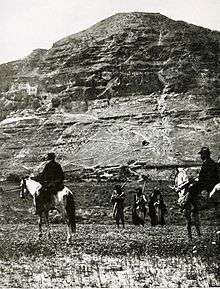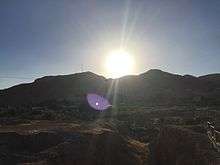Mount of Temptation
The Mount of Temptation is said to be the hill in the Judean Desert where Jesus was tempted by the devil (Matthew 4:8). The exact location is unknown and impossible to determine. It is generally identified with Mount Quarantania, Arabic name: Jabal al-Quruntul, from its Crusader name, Mons Quarantania, a mountain approximately 366 metres (1,201 ft) high, towering from the northwest over the town of Jericho in the West Bank. According to the public domain Catholic Encyclopedia (1907-1914), Quarantania is "a limestone peak on the road from Jerusalem to Jericho".



Description
Halfway up to the top of the mount is the Greek Orthodox Monastery of the Temptation or "Deir al-Qarantal" in Arabic.
Above Qarantal, on top of the cliff, is a modern wall that sits on the ruins of the Hasmonean (later Herodian) fortress Dok or Duq (1 Macc 16:15), mentioned in the First Book of Maccabees, which appears as Dagon in Josephus' "Antiquities of the Jews" (Ant., XIII, viii, 1; BJ, I, ii, 3). The modern wall was built at the end of the 19th century when the Greek Orthodox hoped to raise another monastery on the top of the mount, but ran out of money.
In 1998 an Austrian-Swiss company built a 1,300 metres (4,300 ft)-long cable car from Jericho's Tell es-Sultan, the mound where the prehistorical and biblical towns once stood, to the level of the monastery, in preparation for the year 2000 when large numbers of tourists were expected.[1]
In literature
The Mount of Temptation is mentioned in a poem of the Temptation event by Henry Wadsworth Longfellow.[2]
See also
- Chariton the Confessor, a monk and saint who established a lavra here at the beginning of the 4th century
| Wikimedia Commons has media related to Mount of Temptation. |
References
Sources
![]()
![]()